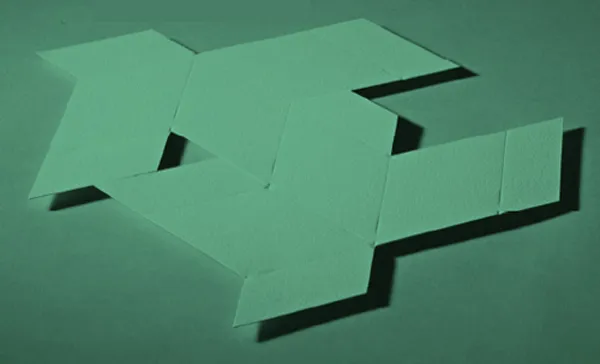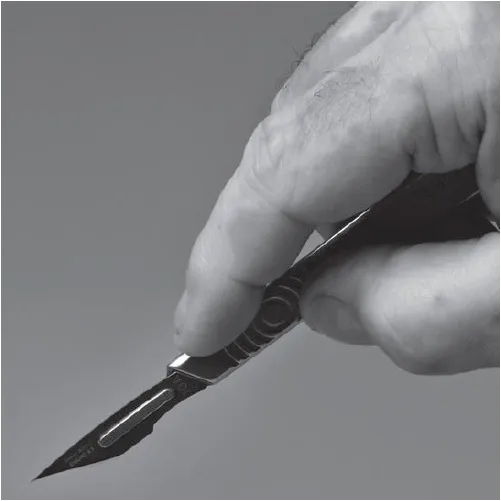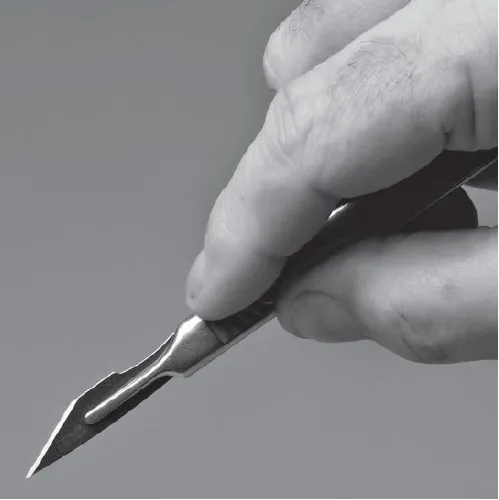![]()
1.1 How to Use the Book
The book presents a step-by-step system to design packaging and other enclosed volumetric forms. You are strongly encouraged to read it sequentially from the first page to the last, as though it were a novel. To flick casually backwards and forwards, stopping randomly here and there to read a little text and look at a few images will probably not be enough for you to learn the method with sufficient rigour to gain any significant and lasting return from the book. Used diligently, the book will enable you to create strong, practical forms of your own design. Used superficially, it will perhaps teach you little.
Chapter 2, How to Design the Perfect Net (pages 14 to 37), is the core of the book. The chapters that follow show how the methods of net design presented in it can be applied. The final chapter presents a series of packaging forms created by students of design at the Hochschule für Gestaltung, Schwäbisch Gmünd, Germany, developed from the forms seen in previous chapters. By working through the book sequentially, you should reach the final pages understanding enough about the theory and application of the net design method to create your own high-quality, original work.
My strong recommendation is to resist temporarily the urge to create. Instead, open yourself to learning and then to applying creatively what you have learnt.
1.2 How to Cut and Fold
1.2.1 Cutting
If you are cutting card by hand, it is important to use a quality craft knife or, better still, a scalpel. Avoid using inexpensive ‘snap-off’ craft knives, as they can be unstable and dangerous. The stronger, chunkier ones are more stable and much safer. However, for the same price you can buy a scalpel with a slim metal handle and a packet of replaceable blades. Scalpels are generally more manoeuvrable through the card than craft knives and are more help in creating an accurately cut line. Whichever knife you use, it is imperative to change the blade regularly.
A metal ruler or straight edge will ensure a strong, straight cut, though transparent plastic rulers are acceptable and have the added advantage that you can see the drawing beneath the ruler. Use a nifty 15cm ruler to cut short lines. Generally, when cutting, place the ruler on the drawing, so that if your blade slips away it will cut harmlessly into the waste card around the outside of the drawing.
It is advisable to invest in a self-healing cutting mat. If you cut on a sheet of thick card or wood, the surface will quickly become scored and rutted, and it will become impossible to make straight, neat cuts. Buy the biggest mat you can afford. Looked after well, it will last a decade or more.
A scalpel held in the standard position for cutting. For safety reasons, be sure to always keep your non-cutting hand topside of your cutting hand.
1.2.2. Folding
While cutting paper is relatively straightforward, folding is less so. Whatever method you use, the crucial element is never to cut through the card along the fold line, but to compress the fold line by using pressure. This is done using a tool. Whether the tool is purpose-made or improvized is a matter of personal choice and habit.
Bookbinders use a range of specialist creasing tools called bone folders. They compress the card very well, though the fold line is usually 1–2mm or so away from the edge of the ruler, so if your tolerances are small, a bone folder may be considered inaccurate.
A good improvized tool is a dry ball-point pen. The ball makes an excellent crease line, though like the bone folder, it may be a little distance away from the edge of the ruler. I have also seen people use a scissor point, a food knife, a tool usually used for smoothing down wet clay, a fingernail (!) and a nail file.
But my own preference is a dull scalpel blade (or a dull craft-knife blade). The trick is to turn the blade upside down (see below). It compresses the card along a reliably consistent line, immediately adjacent to the edge of the ruler.
A scalpel or craft knife makes an excellent tool with which to create a fold. Held upside down against the edge of a ruler, it does not cut the card along the length of the fold line, but compresses it.
1.3 Using Software
When I teach, I must by necessity ask my group to construct their nets manually – it simply isn’t practical to design with a computer. So we make nets using a hard pencil, rulers, a protractor, a pair of compasses, set squares and – of course – erasers. In truth, this is absolutely the best way to learn how to design a net. Later, when a perfect net has been designed, it can be drawn using a computer.
However, the correct ways to draw accurate squares, parallel lines, polygons and so on by hand, and how to calculate angles, are rarely taught now in schools or in design colleges, so when I teach, a lot of time is given to explaining the basic principles of technical drawing. To explain basic TD within these pages is beyond the scope of this book, so the reader wishing to construct by this manual method is encouraged to seek information elsewhere.
More likely though, the reader will use the system of net design presented in this book to create a rough net, which will then be drawn accurately on a computer.
There is a wide choice of excellent CAD software suitable for drawing nets, some of which is available in less po...



